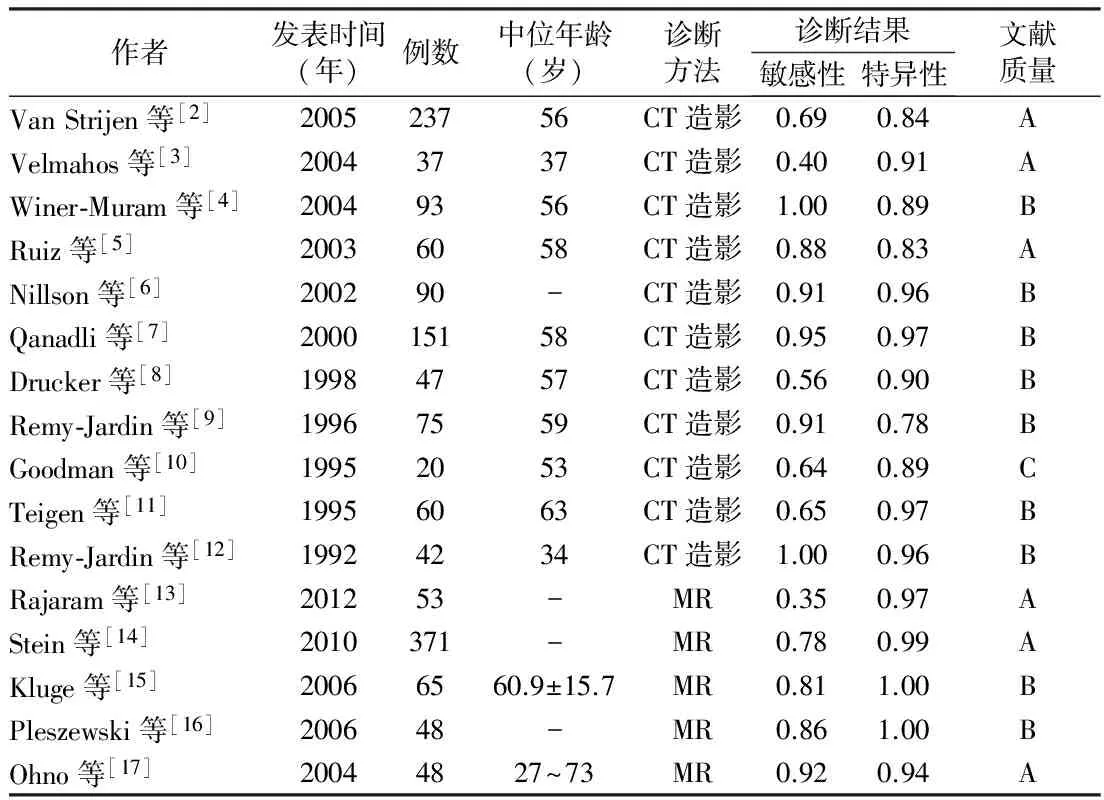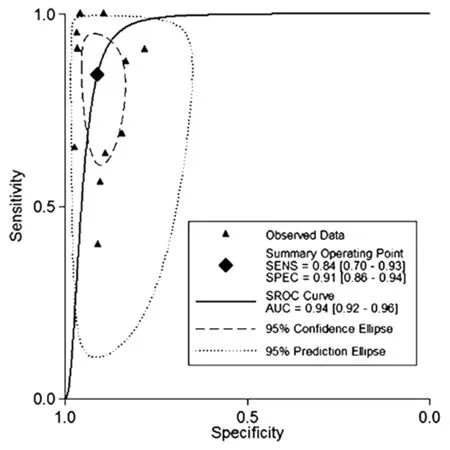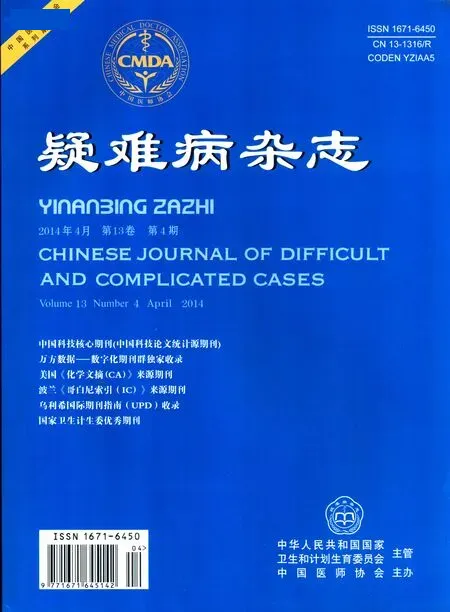CT肺动脉造影与MR诊断肺动脉栓塞临床价值的 Meta分析
周璐,范占明,张兆琪,徐磊,于薇,晏子旭,姜红
荟萃分析
CT肺动脉造影与MR诊断肺动脉栓塞临床价值的 Meta分析
周璐,范占明,张兆琪,徐磊,于薇,晏子旭,姜红
目的对CT肺动脉造影与MR评估肺动脉栓塞(PE)的临床应用价值进行Meta分析。方法网络检索中英文数据库MEDLINE、EMBASE、Cochrane图书馆、CBM、CNKI和万方数据等,搜集公开发表的关于CT肺动脉造影与肺动脉MR评估PE的文献,应用STATA12.0统计软件进行数据合并,计算诊断试验的敏感性、特异性和ROC曲线下面积(AUC)。结果共16项研究1 497例受试对象纳入Meta分析,其中应用CT肺动脉造影评价PE 11项研究,MR检查5项研究。Meta分析结果显示CT肺动脉造影和MR评价PE的敏感性分别为0.79(95%CI 0.75~0.83)和0.54(95%CI 0.48~0.60),特异性分别为0.90(95%CI 0.87~0.93)和0.98(95%CI 0.96~1.00);CT肺动脉造影和MR评价PE的AUC分别为0.94(95%CI 0.92~0.96)和0.99(95%CI 0.97~0.99)。结论CT肺动脉造影与MR评估PE的准确性较高,可作为临床评估PE的有效方法。
肺动脉栓塞;CT;核磁共振成像;Meta分析
肺动脉栓塞(pulmonary embolism,PE)临床上较为常见[1],为内源性或外源性栓子堵塞肺动脉或其分支引起肺循环障碍的临床和病理生理综合征。其中最主要、最常见的类型为肺动脉血栓栓塞(pulmonary thromboembolism,PTE),还包括其他以肺血栓性栓子栓塞为病因的类型,如脂肪栓塞、羊水栓塞、空气栓塞、异物栓塞和肿瘤栓塞。肺动脉栓塞后发生肺出血或坏死者称肺梗死(pulmonary infarction)。肺动脉栓塞主要表现为三联征,包括胸痛、呼吸困难和咯血,但大多数情况下并非所有患者都表现出上述症状,通过临床症状诊断PE往往敏感性和特异性较低,易造误诊或漏诊。近年来随着影像学技术的发展,CT动脉造影和MR被逐渐用于PE的诊断,影像学技术在PE诊断方面显现出了巨大的优势,但由于各研究样本量较小,统计效能较低,其对PE的诊断价值一直存在争议。因此,本研究采用循证医学的方法,对既往关于CT和MR作为检测手段评估PE的临床诊断试验进行汇总并对相关数据进行Meta分析,探讨CT肺动脉造影与MR用于评价PE的临床价值。
1 资料与方法
1.1 文献入选与排除 文献发表语言:英语和汉语;研究类型:前瞻性对照研究;研究对象:临床上可疑PE患者;诊断金标准:肺动脉造影。
1.2 文献检索 采用关键词与自由词结合的方式进行检索相关数据库,EDLINE、EMBASE、Cochrane等英文数据库检索词为 “pulmonary embolism/PE”“Computer tomography” “Magnetic resonance image” 。CBM、CNKI和万方数据等中文数据库检索词为以“肺动脉栓塞” “计算机辅助成像”“磁共振成像”。同时为避免文献丢失,我们还对纳入文献的参考文献进行了手工检索,以发现可能合格的相关研究报道。
1.3 数据提取 根据文献纳入与排除标准进行相关数据库文献检索和文献筛查,纳入符合要求的文献并剔除不符合要求的文献,对于符合要求的文献进行相关数据提取。提取的内容有:作者姓名、文章发表时间、研究实施所在地区、待评价诊断试验、入组患者人数及待评价试验的敏感性、特异性、真阳性、假阳性、假阴性、真阴性。文献纳入采用双人平行评价的方法,对于存在争议的数据则请教相关专家或与第三人讨论,最终决定是否纳入。
1.4 统计学方法 采用STATA12.0软件进行统计分析,将提取的数据输入数据库(EXCEL),统计学异质性采用Q统计量的I2检验,I2<50%认为各研究间不存在异质性,采用固定效应模式(fixed effect model)进行合并;如果I2>50%则认为各研究间存在异质,采用随机效应模型(randomized effect model)进行合并。分别合并诊断实验的敏感性、特异性、阳性似然比、阴性似然比,STATA 11.0统计软件绘制合并后的受试者工作特征(ROC)曲线,计算曲线下面积(AUC)。P<0.05为差异有统计学意义。
2 结 果
2.1 文献检索 依据纳入与排除标准,检索相关数据库,初检索到关于CT肺动脉造影与MR评估PE的临床研究文献共521篇。进一步通过浏览文献的题目和摘要,排除明显不符合要求的研究505项,结果纳入文献16篇,纳入分析的文献具体特征见表1。
2.2 异质性检验 提取16篇原始文献中的诊断真阳性、假阳性、真阴性和假阴性,并根据其具体数值计算诊断试验敏感性和特异性的统计学异质性。异质性检验结果显示,诊断的敏感性和特异性均存在统计学异质性,故采用随机效应模型进行数据合并。

表1 纳入相关文献的基本特征
2.3 敏感性和特异性 采用随机效应模型对纳入分析的数据进行合并,根据贝叶斯定理计算合并的敏感性和特异性,CT肺动脉造影和MR评价PE的敏感性分别为0.79(95%CI 0.75~0.83)和0.54(95%CI 0.48~0.60),特异性分别为0.90(95%CI 0.87~0.93)、0.98(95%CI 0.96~1.00)。见图1。


注:a.CT敏感性;b.CT特异性;c.MR敏感性;d.MR特异性
2.4 诊断效能 CT肺动脉造影和MR评价PE的AUC分别为0.94(95%CI 0.92~0.96)和0.99(95%CI 0.97~0.99)。见图2、3。

图2 CT诊断PE的ROC曲线

图3 MR诊断PE的ROC曲线
3 讨 论
PE在临床诊疗工作中并不少见,来自意大利的流行病学数据显示,PE的年发病率大约在100/10万,但我国关于PE发病率的流行病学数据尚无报道[13]。PE患者临床表现多样且无特异性,根据患者临床特征进行诊断准确性较低。
近年来随着影像学技术的进展,CT肺动脉造影和MR在评估PE方面发挥了重要的作用。CT肺动脉造影可清晰观察到位于肺动脉主干、叶、段肺动脉内的栓子,影像学上表现为肺动脉内充盈缺损及血管截断,并根据其特异性影像学表现判断患者是否发生PE。本文共纳入11篇CT动脉造影评价PE的文献,合并分析其诊断PE的敏感性为0.79(95%CI 0.75~0.83),特异性为0.90(95%CI 0.87~0.93),诊断试验的AUC为0.94(95%CI 0.92~0.96),其评价PE的敏感性和特异性均较高,且有较高的诊断效能。
一般情况下MR可对段以上肺动脉进行良好的显像,理论上其评价段以上肺动脉内栓子的敏感性和特异性较高,有研究报道,MR评估肺段以上栓子的敏感性为75%~100%,特异性为42%~100%,与CT肺动脉造影相似[16],但MR检测本身不需使用造影剂,操作更为简便快捷,这一点对于致死率较高且需快速诊断的PE患者来说至关重要;同时MR可对血栓的内部结构进行分析,判断血栓的新旧程度,为确定溶栓治疗提供依据。本研究对5个前瞻性研究进行了合并分析,结果显示,MR评价PE的敏感性为0.54(95%CI 0.48~0.60),特异性为0.98(95%CI 0.96~1.00),ROC曲线下面积为0.99(95%CI 0.97~0.99),其诊断的敏感性较低,但特异性非常高,临床上可应用其特异性较高的特点作为PE的确诊手段。ROC曲线是一种准确、全面评价诊断试验的有效方法,根据Swets[18]的研究结果,AUC<0.5时无诊断价值;0.5≤AUC<0.7时有较低的准确性;0.7≤AUC<0.9时有较高的准确性;AUC≥0.9时准确性最高。本研究中Meta分析显示CT肺动脉造影和MR评价PE的AUC分别为0.94、0.99,提示CT肺动脉造影和MR作为判断PE的标准其诊断准确性较高。
总之,研究提示CT动脉造影和MR是无创或微创诊断PE的较好方法,具有较好的临床应用价值。同时随着影像学技术的不断发展,CT肺动脉造影和MR将为PE诊断和治疗提供更为可靠的临床资料。
1 钟伟,郑舒展,羊富彬,等. 肺栓塞79例临床诊治分析[J]. 疑难病杂志,2011,10(3):222-224.
2 Van Strijen MJ,De Monye W,Kieft GJ,et al. Accuracy of single-detector spiral CT in the diagnosiSof pulmonary embolism:a prospective multicenter cohort study of consecutive patientSwith abnormal perfusion scintigraphy[J]. J Thromb Haemost,2005,3(1):17-25.
3 VelmahoSGC,ToutouzaSKG,Vassiliu P,et al. Can we rely on computed tomographic scanning to diagnose pulmonary embolism in critically ill surgical patients[J].J Trauma,2004,56(3):518-525; discussion 525-526.
4 Winer-Muram HT,Rydberg J,Johnson MS,et al. Suspected acute pulmonary embolism:evaluation with multi-detector row CT versuSdigital subtraction pulmonary arteriography[J]. Radiology,2004,233(3):806-815.
5 Ruiz Y,Caballero P,Caniego JL,et al.Prospective comparison of helical CT with angiography in pulmonary embolism:global and selective vascular territory analysis. Interobserver agreement[J]. Eur Radiol,2003,13(4):823-829.
6 Nilson T,Soderberg M,Lundqvist G,et al.A comparison of spiral computed tomography and latex agglutination D-dimer assay in acute pulmonary embolism using pulmonary arteriography aSgold standard[J]. Scand Cardiovasc J,2002,36(6):373-377.
7 Qanadli SD,Hajjam ME,Mesurolle B,et al. Pulmonary embolism detection:prospective evaluation of dual-section helical CT versuSselective pulmonary arteriography in 157 patients[J]. Radiology,2000,217(2):447-455.
8 Drucker EA,Rivitz SM,Shepard JA,et al. Acute pulmonary embolism:assessment of helical CT for diagnosis[J]. Radiology,1998,209(1):235-241.
9 Remy-Jardin M,Remy J,Deschildre F,et al. DiagnosiSof pulmonary embolism with spiral CT:comparison with pulmonary angiography and scintigraphy[J]. Radiology,1996,200(3):699-706.
10 Goodman LR,Curtin JJ,Mewissen MW,et al. Detection of pulmonary embolism in patientSwith unresolved clinical and scintigraphic diagnosis:helical CT versuSangiography[J]. AJR Am J Roentgenol,1995,164(6):1369-1374.
11 Teigen CL,MauSTP,Sheedy PF 2nd,et al. Pulmonary embolism:diagnosiSwith contrast-enhanced electron-beam CT and comparison with pulmonary angiography[J]. Radiology,1995,194(2):313-319.
12 Remy-Jardin M,Remy J,Wattinne L,et al. Central pulmonary thromboembolism:diagnosiSwith spiral volumetric CT with the single-breath-hold technique-comparison with pulmonary angiography[J]. Radiology,1992,185(2):381-387.
13 Rajaram S,Swift AJ,Capener D,et al. Diagnostic accuracy of contrast-enhanced MR angiography and unenhanced proton MR imaging compared with CT pulmonary angiography in chronic thromboembolic pulmonary hypertension[J]. Eur Radiol,2012,22(2):310-317.
14 Stein PD,Chenevert TL,Fowler SE,et al. Gadolinium-enhanced magnetic resonance angiography for pulmonary embolism:a multicenter prospective study (PIOPED III) [J]. Ann Intern Med,2010,152(7):434-43,W142-143.
15 Kluge A,Luboldt W,Bachmann G. Acute pulmonary embolism to the subsegmental level:diagnostic accuracy of three MRI techniqueScompared with 16-MDCT[J]. AJR Am J Roentgenol,2006,187(1):W7-14.
16 Pleszewski B,Chartrand-Lefebvre C,Qanadli SD,et al. Gadolinium-enhanced pulmonary magnetic resonance angiography in the diagnosiSof acute pulmonary embolism:a prospective study on 48 patients[J]. Clin Imaging,2006,30(3):166-172.
17 Ohno Y,Higashino T,Takenaka D,et al. MR angiography with sensitivity encoding (SENSE) for suspected pulmonary embolism:comparison with MDCT and ventilation-perfusion scintigraphy[J]. AJR Am J Roentgenol,2004,183(1):91-98.
18 SwetSJA. ROC analysiSapplied to the evaluation of medical imaging techniques[J]. Invest Radiol,1979,14(2):109-121.
TheclinicalvalveofCTandMRintheassesofPE:AMeta-analysis
ZHOULu,FANZhanming,ZHANGZhaoqi,XULei,YUWei,YANZixu,JIANGHong.
DepartmentofRadiology,CapitalMedicalUniversityAffiliatedBeijingAnzhenHospital/BeijingInstituteofCardiopulmonaryVascularDisease,Beijing100029,ChinaCorrespondingauthor:FANZhanming,E-mail:fanzm120@126.com
ObjectiveTo investigate the CT and MR in the diagnosiSof pulmonary embolism(PE) by using evidence based medicine.MethodsBy searching MEDLINE,EMBSE,Cochrane library,CBM,CNKI and Wanfang dade et al,the prospective clinical trialSof the of CT and MR in the diagnosiSof pulmonary embolism (PE) were included in the Meta-analysis,then use STATA12.0 software to combine the data,calculate the sensitivity,specificity and area under ROC(AUC).Results16 paperSwere recruited in the study with 1 497 cases,including 11 paperSabout CT pulmonary artery angiography and 5 paperSabout MR exam. The pooled sensitivity,specificity,and ROC curve were 0.79 (95%CI 0.75-0.83),0.90 (95%CI 0.87-0.93) and 0.94 (95%CI 0.92-0.96) respectively for CT pulmonary artery angiography. And 0.54 (95%CI 0.48-0.60),0.98 (95%CI 0.96-1.00) and 0.99 (95%CI 0.97-0.99) respectively for MR.ConclusionCT pulmonary artery angiography and MR were relative high in the diagnosiSof PE,which can be a useful tool for non-invasive diagnosis.
Pulmonary artery embolism; Computer tomography; Magnetic resonance image; Meta-analysis
北京市自然科学基金面上项目(No.7132086)
100029 首都医科大学附属北京安贞医院/北京市心肺血管疾病研究所影像科
范占明,E-mail:fanzm120@126.com
10.3969 / j.issn.1671-6450.2014.04.025
2014-10-20)

